| Microcrystalline in 30 SecondsBehold the smooth, sweet powers of liquid N. |
| |
|
| |
Liquid nitrogen is cold. Very cold. So cold that if a drop falls on your hand, it feels like fire. So cold that it can turn a fresh flower into a thousand shards of broken glass. So cold that it can make half a gallon of ice cream in 30 seconds flat.
I first heard about liquid nitrogen ice cream from my friend Tryggvi, an Icelandic chemist working in the Midwest (these things happen). He suggested we make it for dessert at a dinner party I was planning. Yes, he said, he had a recipe, something he'd seen in Chemical and Engineering News.
Now, right off the bat you have to worry about a recipe found in Chemical and Engineering News, the principal trade publication for the sort of people who build oil refineries, shampoo factories and large-scale plants for the fractional distillation of liquefied air (which is where liquid nitrogen comes from). But for the party I was planning, it was perfect: The well-known author Oliver Sacks was coming to visit with my collection of chemical elements; I needed some after-dinner entertainment.
My first concern was whether we would survive the ice cream. That and, if it didn't kill the cook, whether it would be any good. I had visions of hard, crusty stuff that caused frostbite of the throat. It turned out nothing could be further from the truth.
We mixed up a standard ice cream recipe calling for two quarts of cream, sugar, eggs, vanilla and flavoring. (Just about any ice cream recipe and flavor will work.) Then, working in a well-ventilated area (lest the nitrogen displace oxygen from the air) and with due regard for the ability of liquid nitrogen to freeze body parts solid, we gently folded about two liters of nitrogen syrup directly into the cream, much as you would fold in egg whites.
The result, literally 30 seconds later, was a half-gallon of the best ice cream I'd ever tasted. The secret is in the rapid freezing. When cream is frozen by liquid nitrogen at -196°C, the ice crystals that give bad ice cream its grainy texture have no chance to form. Instead you get microcrystalline ice cream that is supremely smooth, creamy and light in texture. Martha Stewart, eat your heart out.
The kids were amused by the clouds of water vapor, though being kids they didn't find anything out of the ordinary in the procedure. They probably think everyone makes ice cream this way. Boy, will they be in for a shock the first time they see it done the old-fashioned way at camp: You want me to do what for a half hour?
A word of caution: Liquid nitrogen can be dangerous in careless hands. Tryggvi and I are both trained chemists, and he actually knows what he's doing. Don't try anything like this unless you do too.
Scan of printed version:
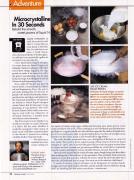 |
| |
|
| |
|
| |
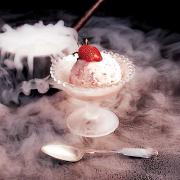
The ice cream was ready to eat when smooth and free of lumps.
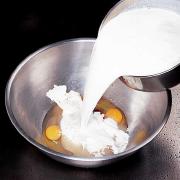
The non-cryogenic ingredients were combined in a mixing bowl.

The concoction was stirred thoroughly and continuously to keep an unbreakable crust from forming.
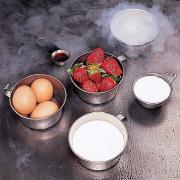
Besides the liquid nitrogen, no special ingredients were used in this experiment.
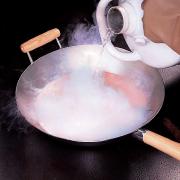
The nitrogen was added a cup at a time. Note the use of heavy cryo gloves-this was not an occasion for oven mitts.
Photo Credits:
Jeff Sciortino; Kelly McKaig
Jeff Sciortino; Kelly McKaig
Jeff Sciortino; Kelly McKaig
Jeff Sciortino; Kelly McKaig
Jeff Sciortino; Kelly McKaig
|
|